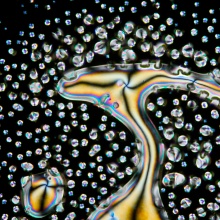Research
Our main research direction is the structure and dynamics of the liquid-crystalline state of matter. Liquid crystals constitute a distinct thermodynamic state of condensed matter, which combines the fluidity of ordinary liquids with the macroscopic anisotropy of solid crystals. They are quintessential soft matter materials and provide an excellent testing ground for the advancement of essential concepts in condensed matter science, such as self-organization, phase transitions, hydrodynamics and elasticity. Systems exhibiting liquid crystalline order range from small rod- or disc-shaped organic molecules (e.g., the ‘classic’ liquid crystals used in LCD devices), over polymers, dispersions of micelles and nanoparticles (e.g., CNTs and viruses) to certain quantum electronic materials.
We are a mainly experimental physical chemistry group with close collaborations to synthetic and theory groups. Our research aims to elucidate the relations between the molecular structures, the symmetry and order parameters of liquid crystalline ordering, and the macroscopic properties of liquid crystals. We are particular interested in the unique chirality effects in liquid-crystalline systems, leading to self-organized chiral nanostructures which mimic the liquid-crystalline structures found in biological matter (such as cholesterol-containing cell membranes or columnar DNA).
Current research fields
Liquid crystal structures & order parameters
Liquid crystalline ordering is intermediate between the short-range order in ordinary fluids and the true 3D long-range order in solid crystals. Liquid crystal structures are thus unique in that they combine aspects of fluid short-range order with aspects of solid-like long-range order. All liquid crystals exhibit at least …
[more …]
Phase transitions & collective phenomena in liquid crystals
Phase transitions – the physical transformations between the various states of matter – are among the most remarkable examples of collective phenomena in nature. They are signified by abrupt changes in certain macroscopic properties, the origin of which is …
[more …]
Chirality effects in liquid crystals
Chirality in liquid crystals has many striking consequences, the most common being helical super-structures which give the phases huge optical activity and an optical band gap. The latter means that many chiral liquid-crystal phases are self-organizing photonic crystals …
[more …]
Liquid crystal nanoscience & soft self-assembly
The emerging field of liquid crystal nanoscience crosses the borders between classic liquid crystal research and nanotechnology. Examples are the liquid-crystalline phase behavior of nanoparticle dispersions, the self-assembly and alignment of nanomaterials in…
[more …]
Liquid crystal semiconductors
Since the discovery of Haarer et al. in 1993 [Phys. Rev. Lett. 70, 457 (1993)] that the columnar phases of discotic liquid crystals are 1D-photo-conductors, the electric charge transport in columnar liquid crystals has turned into one of the most active fields in organic materials leading to potential applications such as …
[more …]

Frank Gießelmann
Prof. Dr.Professor
- Profile page
- +49 711 685 64460
- Write e-mail
- Secretary: Room 9-102; Tel. +49 711 685 64491

Nadia Kapernaum
Dr.Senior Scientist







